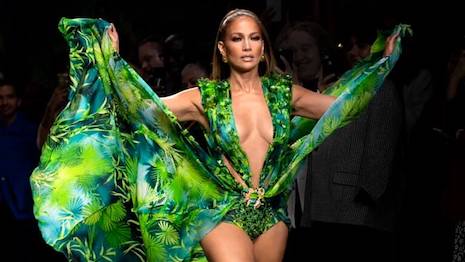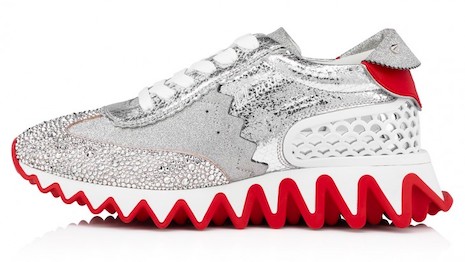Influencers, celebrities and owned media channels are powerful promotional tools during fashion weeks, with these placements generating a greater portion of impact value for brands than their share of voice.
According to data from Launchmetrics, media coverage represented about seven-tenths of the total placements for brands during the major fashion months, and around half of the total media impact value was generated by the press and blogs. Among the drivers of media value during runway shows last year were stunts and sustainability, as brands attracted press through environmental efforts and large-scale catwalk moments.
"Last season was unique in the sense there were several newsworthy moments that generated the interest of the greater public," said Alison Bringé, chief marketing officer at Launchmetrics, London. "Influencers and celebrities are great opinion leaders when it comes to creating awareness, yet it only reaches as far as their sphere of influence, whereas the media can connect with a greater audience and translate what happens on the runways to the regions and audience in question.
"Between the Jennifer Lopez appearance to the steps taken in the realm of sustainability on behalf of global brands such as Dior or Gucci, the media certainly had more than enough to speak to and didn't hesitate to cover the stories in the consumer press," she said.
Media mentions
Across the fashion weeks in New York, Paris, London and Milan, New York had the most media impact value last year. The spring season overall had more buzz surrounding it, but London balked the trend with a stronger media presence for the fall runways.
Influencers accounted for 90 percent of the top social media posts during the fall fashion weeks, while celebrities and influencers were 100 percent of the most impactful social posts from the spring runways.
Versace was the top brand across all four major fashion weeks during the spring/summer 2020 season, generating about $22 million in media impact value. The brand’s Milan show featured Jennifer Lopez modeling a new version of the gown she wore to the 2000 Grammy Awards.
 Jennifer Lopez walked during the finale of Versace's show. Image credit: Versace
Jennifer Lopez walked during the finale of Versace's show. Image credit: Versace
Similarly to the original dress, which led to the creation of Google Image searches due to the influx of queries for a photo of the look, the new iteration also made a splash.
Another way in which brands drove MIV was through launches timed to coincide with their runway shows. For instance, Victoria Beckham debuted a new beauty line alongside her London Fashion Week show, boosting her own MIV through primarily owned media.
Another way that brands attracted attention was through values. Gucci’s Milan Fashion Week announcement that it was going carbon neutral helped its media impact value rise 40 percent over its previous show.
Similarly, Dior spoke to the importance of biodiversity through a runway show that included live trees in the space, which were then planted around Paris. This boosted Dior’s MIV during the spring 2020 season 57 percent more than its fall 2019 show.
In recent years, runway shows have been increasingly turning into consumer-facing events courtesy of livestreaming and social media access. However, this past year saw this shift accelerate.
The British Fashion Council staged its first London Fashion Week events that were open to the public (see story). This in turn helped to boost media impact for brands including House of Holland.
Runway shows are also becoming more inclusive, both on the catwalk and in the audience.
For instance, Tommy Hilfiger’s collaboration with Zendaya led to a runway show that received positive press for the brand, with media accounting for 63.3 percent of the show’s MIV.

Tommy Hilfiger's show. Image credit: Tommy Hilfiger
With luxury brands having an increasingly global presence, the media impact of fashion weeks in the U.S. and Europe extended beyond these regions to areas including Brazil and China. This international approach is also affecting how brands are staging their shows, with many opting to take their collections on holiday to a destination outside of their hometowns.
"In order to create viral moments at their shows, brands should think beyond the runway and industry confines," Ms. Bringé said. "If you look at the Versace spring/summer '20 show, the success was due to the fact that they were able to resonate beyond the fashion world and speak on greater, global trends.
"They connected with the average consumer through early '00s nostalgia and by linking the story to the creation of Google Images, which is something that we can all relate to," she said. "To that note, brands should consider building moments that are true to their values but also true to the current societal undertones."
Value of values
Transparency around a brand’s corporate values is of increasing importance to consumers, particularly millennials and Generation Xers.
A new report from Clutch found that 71 percent of shoppers believe it is important for a company to take a side on social issues. Since a majority of respondents are likely to stop buying from a brand that supports an issue that goes against their personal values, companies must tread carefully (see story).
Rather than relying on governmental regulations alone to combat climate change, companies should get involved and go beyond these guidelines in part because it is financially sound, according to a new report from Positive Luxury.
Consumers are becoming more vocal about the need for change, whether it is children gathered in solidarity with Greta Thunberg or Extinction Rebellion protesting fashion consumerism. Per the report, collaboration is key for companies to make a marked difference in the 2020s, as the private and public sector need to come together to tackle issues such as shrinking biodiversity, emissions, natural resource usage and waste (see story).
"It is more clear than ever that brands need to take action when it comes to sustainability and socially responsible subjects, how brands do that vary according to the brand itself," Ms. Bringé said. "The actions must remain authentic as consumers seek transparency and are quick to call out brands who use 'greenwashing' and marketing tactics purely to sell.
"Companies must stop trying to be everything to everyone and start refining their strategies, both internally and externally, so it reflects their stance on today's issues," she said.
";
}
$token = ld16_get_token($post->ID);
$encrypted = ld16_encrypt($encrypted, $token);
print $encrypted;
?>




















